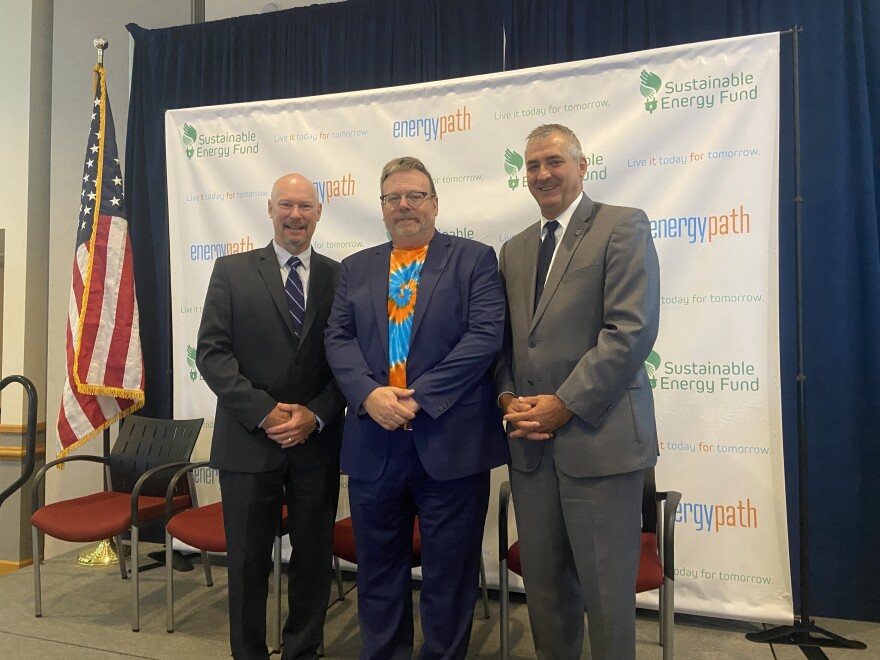UPPER SAUCON TWP., Pa. — With a wealth of natural resources as diverse as wood, coal and natural gas, Pennsylvania has been “one of the top energy producers in the nation,” David Althoff Jr. said Wednesday.
“These shifts over time that we have experienced means that we are practiced at harnessing our diverse energy resources," Althoff, director of the Energy Programs Office at the state Department of Environmental Protection, said.
"And it's in our nature to continue that evolvement with regards to our resources. Why would we think that we're not going to continue to solidify the commonwealth’s role as an energy leader? This is really part of our DNA.”
Althoff was opening speaker during the Sustainable Energy Fund’s Energypath 2025 conference, focused on regenerative energy.
Held at DeSales University’s Gerald White Conference Center, the day-long event drew several dozen participants, including students, teachers and local environmental advocates and leaders.
“We've been to a lot of places,” John Costlow, chief executive officer of the Sustainable Energy Fund, said. “We're going to a lot of places — and regenerative energy is that next place.
“And you guys are going to hear about the leading edge today. Throughout the day, we'll explore the energy transition, what it looks like, where we came from [and] where we're going.”

‘A clean grid that's central’
During Althoff’s opening speech outlined ways in which the commonwealth has been an energy leader.
Those include starting the first major coal mining production in the country, using of electricity via wood and coal and, in 1957, opening the first commercial nuclear power plant in the United States.
“Society has been shaped by the resources that we have harnessed in Pennsylvania and the inventions that have come to light in Pennsylvania,” he said.
"As our personal energy needs continue to increase because of the devices that we use and the expectations that we have, and as a country becomes more reliant on technology and more hungry for the energy to create comfort and convenience in our lives.”David Althoff Jr., director of the Energy Programs Office at the state Department of Environmental Protection
“And what I think we need to realize is that, with each passing day, energy becomes a more critical part of our daily lives.
"As our personal energy needs continue to increase because of the devices that we use and the expectations that we have, and as a country becomes more reliant on technology and more hungry for the energy to create comfort and convenience in our lives.”
Officials need to find solutions for those increased needs both reliably and affordably, Althoff said, He said his office is focused on “affordable, at-hand, local fuels in our communities.”
At the same time, there’s climate change to consider, he said, citing the 2024 Pennsylvania Climate Action Plan, released in April during an Earth Week celebration.
“Pennsylvania could find itself on a path to net zero by 2050, but we have to implement every strategy that is in that report, and we still might not get there, relative to the model,” he said.
“So what this means is that we need to find even more reductions to meet both the short term goals in 2030 and the long term goals in 2050.
"And I will tell you one of the key actions in that plan is a clean grid that's central to decarbonization of nearly every sector, including buildings, transportation and industry — that is imperative that we do that.”
‘This is jobs’
Implementing all the strategies in the plan would net more than 26,000 jobs per year, Althoff said.
“This is not an economic killer. This is not a jobs killer. This is jobs. This is shifting how we operate in order to fulfill what we need to do from a climate action standpoint.”David Althoff Jr., director of the Energy Programs Office at the state Department of Environmental Protection
“This is not an economic killer. This is not a jobs killer,” Althoff said. “This is jobs. This is shifting how we operate in order to fulfill what we need to do from a climate action standpoint.”
He showed maps illustrating extreme temperatures and precipitation — only expected to get worse as time goes on.
“While heat is a killer, flash floods are a killer, too, and this impacts all that we do,” he said.
“Environmental justice communities will have greater exposure to extreme heat and flooding compared to the statewide averages.
"EJ areas are 1.9 times as likely to experience days over 90 degrees, and 1.2 times as likely to have their communities within flood prone areas.
“So we are facing extreme weather events and constantly testing the limits of our energy.”
Of the Lehigh Valley’s major cities, Allentown, Bethlehem and Easton, all have tracts categorized as an Environmental Justice Area.
A surge in electricity demand
Stephen M. DeFrank, chairman of the state Public Utility Commission, said it was “inspiring” to be at the conference.
“I look around, I see the people who are shaping the energy future in Pennsylvania and beyond, industry professionals, policy makers, academics, students, innovators and community leaders, each of you brings a piece to the puzzle,” DeFrank said in his keynote address.
“It's going to take all of us working together to put that puzzle together to solve the challenges we face.”
“The energy system that has powered our homes, our businesses and our communities for over a century is being reshaped in real time. That transformation is being driven by a combination of urgent challenges and powerful opportunities.”Stephen M. DeFrank, chairman of the state Public Utility Commission
The commission has jurisdiction over electric distribution systems throughout the state, including overseeing the interconnection of net meter systems and establishing rates for distribution services, “ultimately work[ing] to ensure the lights stay on,” he said.
And demand for electricity is surging.
“We're living through a moment of extraordinary transformation,” DeFrank said.
“The energy system that has powered our homes, our businesses and our communities for over a century is being reshaped in real time. That transformation is being driven by a combination of urgent challenges and powerful opportunities.”
The large-scare electrification of transportation, heating and industry is accelerating, he said. At the same time, there’s explosive growth of energy-intensive industries, like data centers and AI computing.
“The idea that we can just pour concrete, string wires and erect new power plants fast enough to keep pace is unrealistic,” he said.
“But what we can do, and what we must do, is approach this challenge on multiple levels. We can make our existing grid smarter, more efficient and more responsive.
"We can expand demand-side tools that help us manage peak load and reduce stress during critical times. We can accelerate deployment of cleaner, more flexible generation.
"And we can look to unlock the creativity, innovation and urgency that I know that is in this room today.”
Other scheduled sessions during the conference included seven lightning talks, including “Advancements in Solar PV,” “Energy Controls” and “The Water Cost of Electricity on the Susquehanna River,” among others. There were also panels and breakout sessions.


